april 2023

an Integral Part of Your Process
Make CIP
In the same way you use automation to make consistent, quality products, why not use CIP to ensure germ-free cleaning every time?
BY Wayne Labs, senior Contributing technical editor
Mix-proof valves takes the guesswork out of the CIP process by automating the switching of valves to a prescribed format for cleaning, reducing the possibility of operator error. Photo courtesy of Wayne Labs
You’ve automated your process and packaging and have computer-generated paper trails to show food safety and quality throughout your facility. Why wouldn’t you do the same with cleaning—wherever it’s practical? Granted, there are certain pieces of equipment you just have to take out of the process to clean manually, but for other components—like piping, some conveyor belting, certain pumps, mixers, tanks and other equipment—you can clean them in place (CIP) and have automated recordkeeping to show proof of cleaning and sanitation to regulating bodies when they ask.
CIP is an integral part of cleaning and sanitation, which affects the food safety of any facility. Cleaning and sanitation not only help you comply with regulatory requirements, but also protect consumers and your brand from contamination and recalls, says Pablo Coronel, Ph.D., CRB senior fellow - food process & food safety.
CIP is carried out in process lines without dismantling and must reach every nook and cranny of the process equipment; thus, well-designed equipment that is amenable to CIP (as opposed to COP—clean out of place) is a must for any installation. Materials of construction, drainability, ease of cleaning and prevention of dead areas/zones are some of the criteria for design, adds Coronel.
Besides the equipment design, a successful CIP system depends on several variables, such as water flow rate and temperature, chemicals used (concentration) and time of cleaning. These variables are set in cooperation with the chemical supplier by the characteristics of the product to be cleaned (viscosity, stickiness, amount of fouling and presence of allergens) and the equipment that needs to be cleaned. The presence of allergens, however, can complicate the CIP process.
CIP must be validated for each product (or family of products) to ensure that it is efficient, i.e., it brings the process equipment or line back to a clean state. Think of validation as a food safety preventive control, says Coronel.
Automation comes to the aid of an efficient CIP by ensuring that the right cycle is used with each product. During validation of CIP per product, a “recipe” is established for the cleaning and is applied by knowing which product was made. CIP systems can either automatically—or with human intervention—determine the optimal CIP recipe and monitor the use of chemicals and water as well as flow rate and temperature. Further advances in sensors can also help determine when the equipment is clean. CIP automation is one of the improvements for food safety and sustainability that any facility can implement, says Coronel. “Automation of CIP helps with consistency, record keeping and monitoring, which is an integral part of the food safety plan.”
CIP skids can also include steam-in-place (SIP) and are often custom built for specific applications. HRS Heat Exchangers produces a wide range of CIP and SIP systems. Photo courtesy of HRS Heat Exchangers
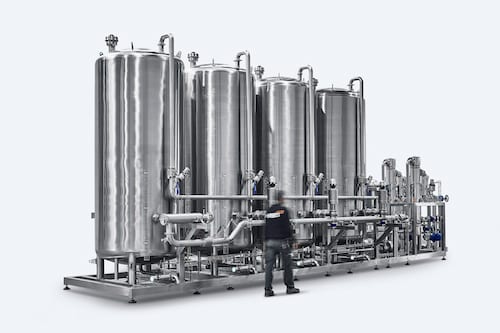
Look at the Process to Understand CIP needs and Water Quality
“There are several things to consider when you start looking at the process,” says Neil Bogart, executive area technical support coordinator, Ecolab Food & Beverage. “The first thing to understand is the soils you are dealing with; which soil in the product matrix is the hardest to remove? Then there’s water quality. Since the CIP cleaning solution is made up of 95-99.5% water, we have to ensure the chemistry is not affected by impurities like hardness, alkalinity, chlorides, sulfates or metal ions.”
For example, water can contain varying levels of calcium and magnesium bicarbonates, which are temporary, and carbonates, which are permanent. The higher the content, the harder the water. The chemistry of calcium and magnesium makes them less soluble in water under normal cleaning and sanitizing processes, causing scaling that can bind the cleaning chemistry and not allow it to be active in the wash. As a result, more chemistry will be needed to overcome higher levels of hardness. Since the amount of calcium and other minerals in the water varies from place to place, the concentration of detergent and sanitizer choice can only be established once the water hardness and other contents and characteristics are known.
For smaller operations, Sani-Matic’s CIP Mini offers functionality for several process applications. Photo courtesy of Sani-Matic
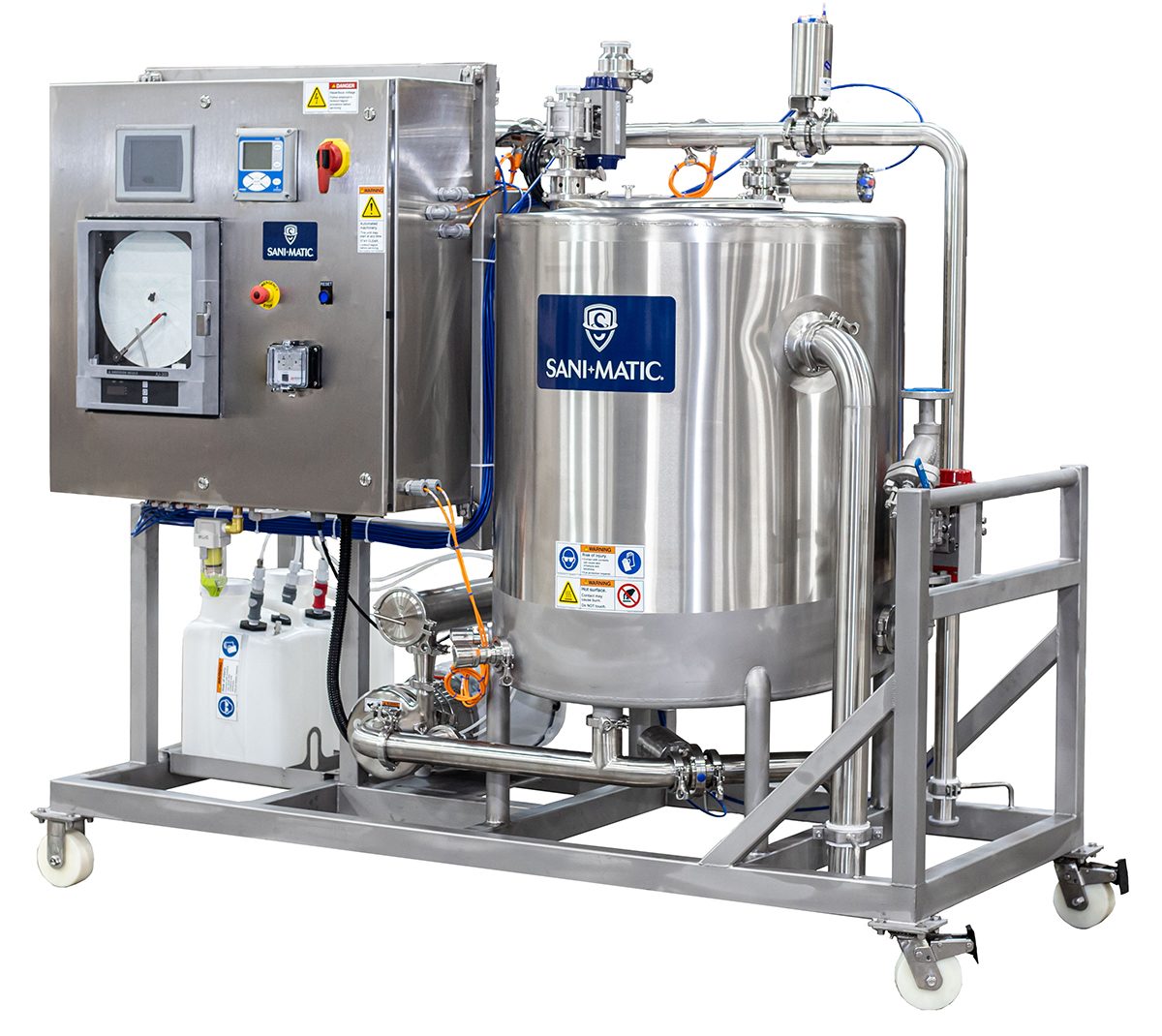
“The next things to consider are the characteristics of the CIP, temperatures, desired times and the mechanical force the system will deliver,” adds Bogart. “Once all of this is understood, we can match the soil, water and CIP characteristics to the chemistry that will be most effective in removing the defined soil, at the desired temperature, time and mechanical force available.”
Three major types of chemicals used for CIP are caustic wash, acid wash and sanitizer, says Adam Richards, food safety engineer, principal consultant, process, Gray Solutions, a Control System Integrators Association (CSIA) member. The most common chemicals used for caustic wash are sodium hydroxide or chlorinated alkaline with a pH in the 10-13 range. The purpose of the caustic wash is to remove residual buildup in process lines and equipment, soil buildup, leftover product, and proteins. Acids are primarily comprised of phosphoric acid and/or nitric acid. The acid wash step is critical in removing the scale buildup inside the lines but can also be used as a neutralizer to help balance the pH of the system. Sanitizers that have been widely used are hypochlorite solutions (potassium, sodium or calcium) because the main ingredient is chlorine. Most recently, sulfur dioxide has emerged as the alternative sanitizer for poultry, fruit processing and breweries due to its oxidizing power and being less corrosive to equipment. Another alternative for sanitizing is peracetic acid, which is a mixture of hydrogen peroxide and acetic acid. It works well even at low temperatures, leaves little chlorine residue after the rinse cycle, and it is effective for all microorganisms.
CIP: No Longer an Island of Automation
“The trend toward reducing ‘islands of automation’ is relevant for CIP systems for many reasons,” says Alan Maxwell, VP of process industries, E Tech Group, a CSIA Certified Member. “It can be practical to integrate what may traditionally have been a standalone manual or semi-automatic system into the broader process control system. The decision becomes even easier when you realize machine-level edge technologies and peer-to-peer Ethernet network connectivity allow for this to be done easily and cost-effectively.”
Maxwell notes other reasons for integration:
• Data historians provide CIP trending and reporting through dashboards,
• Programming PLCs in CIP systems can be done remotely via Windows standard interfaces—rather than being onsite,
• Integrating the CIP system with the process control system allows for flexibility in scheduling different products sequentially.
With many of today’s process systems, you can think of CIP as part of the process. “A CIP system is used in processes that have equipment that are not easy to be dismantled for a cleaning process, because it can be both time consuming and cause mechanical damage if taken apart daily,” says Pavitra Pearson, senior project manager, Novolyze. “It is hands-off for most part.” Think of CIP as more of an automated system, which is plug-and-play and requires an operator to monitor the system.
Novolyze’s platform allows monitoring of key food safety parameters with a single tool. “Indeed, CIP is part of process control since the performance of delivering a clean process is critical. Environmental monitoring is another part of the platform offered by Novolyze,” says Moussa Ndiaye, product manager. “Having a centralized place that combines essential food safety data is a must-have to make fast and efficient decisions.”
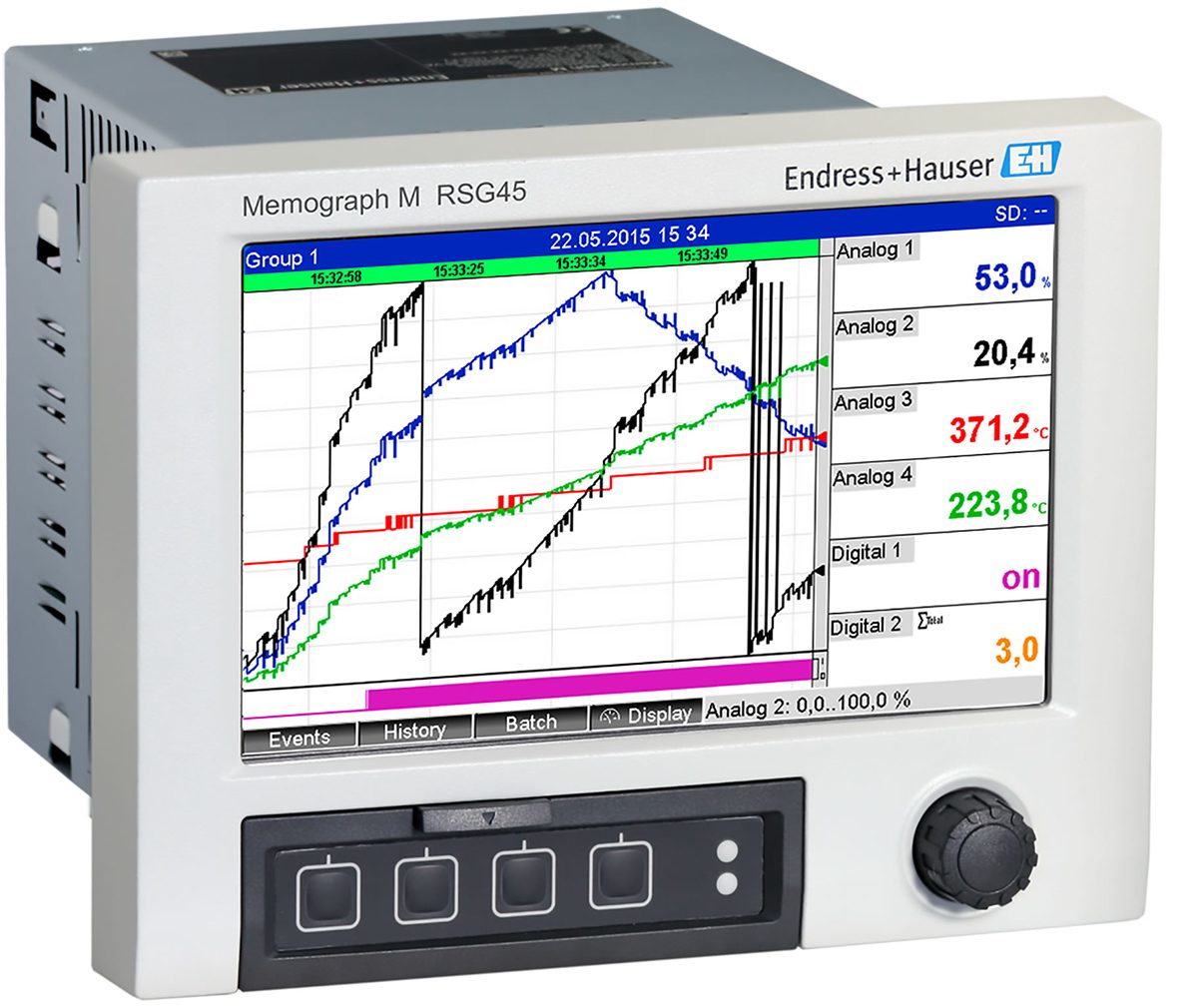
Digital recorders, like the Endress+Hauser Memograph M RSG45, help food processors historize and trend CIP and other process data. Photo courtesy of Endress+Hauser
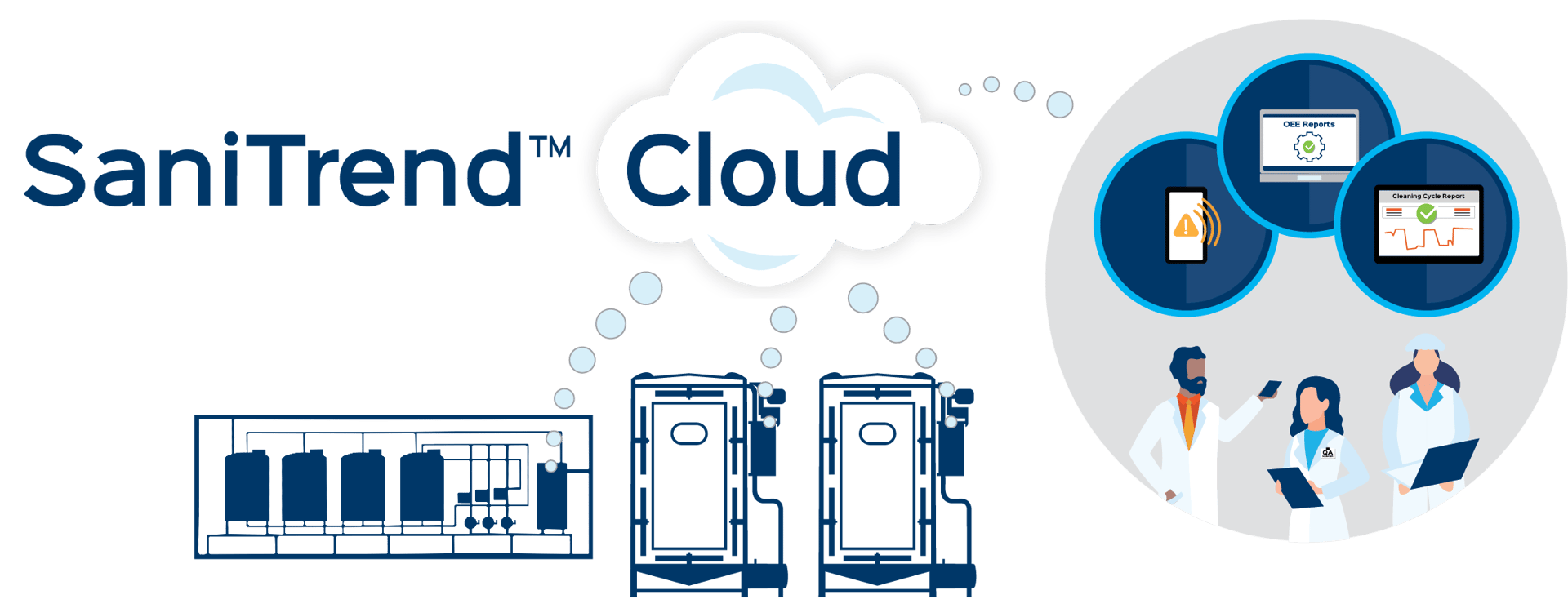
Sani-Matic’s SaniTrend Cloud product allows for instant and complete CIP data access securely with just accessing an online portal with this information. Image courtesy of Sani-Matic
One of the major focus areas of a CIP project today is not only the automation of the CIP itself, but the integration of how that CIP works and communicates with other pieces of process equipment, says Pete Barrie, product management director, Sani-Matic. “When we are doing CIP of process equipment (which is more automated than ever), more communication needs to occur—ensuring the equipment is ready for CIP, making sure valves that need to be opened are opened, turning on an agitator shaft, etc. With a more ‘connected plant,’ the CIP needs to be more connected to that plant equipment as well.”
“All of our food production systems and heat exchangers either include CIP systems as standard, or are designed to connect with wider factory CIP systems and protocols,” says Matt Hale, international sales & marketing director for HRS Heat Exchangers. These integrated CIP systems include the control systems operated from the main PLC controls, meaning that system emptying, cleaning and refilling can be a simple one-touch operation. In addition, full records are kept of the cleaning cycle, allowing full traceability and quality control, says Hale.
Flexibility is a good practical reason for CIP integration, according to Paul Ericksen, manager, automation, Gray Solutions. “We can determine ‘strengths’ of CIP requirements if we know what product was just run and which one is to be run next; for example, if going from Product A to Product B, perhaps only a simple rinse is required, but going from product B to product C may require a full hot wash.” This level of integration can eliminate unnecessary washes, says Ericksen. “The CIP system could keep track of which circuit has been cleaned, by what cycle, and how long ago; and interlocks could be programmed into the production system based on requirements. The CIP system could also tailor chemical concentrations, wash temperature, wash time—and even choose between different chemicals based on this information.”
The Case for Mix-Proof Valves in CIP Systems
Today, mix-proof valves are a necessary part of most automated CIP systems. Having a design with mix-proof valves in the process does add programming time, but greatly improves efficiencies since flow plates do not need to be changed daily, and wrong connections are avoided. There is a significant upfront cost with the additional hardware, but time savings per day will easily pay for it with a short ROI.
Mix-proof valves also allow for simultaneous cleaning of a circuit while continuing to produce on another. This is very common in dairy or other fluid applications where product lines can be cleaned while supply lines to the process are still available for use by production. By leveraging this functionality, significant efficiency can be gained and offset the cost of the installation.
—Tim Barthel, vice president of automation solutions, and John Tertin, director of solutions engineering, Cybertrol Engineering
Having the Data You Need to be Competitive and Prove Compliance
“Without continuous measurement of CIP control parameters, staying competitive is nearly impossible in today’s food processing landscape,” says Ola Wesstrom, Endress+Hauser food & beverage industry marketing manager. Without good CIP data, contamination risks inevitably result in wasted product, water, energy, and detergents—or worse, recalls. In most cases, CIP parameters are captured in a historian via PLC communication pathways, or in standalone digital recorders, like the Endress+Hauser Memograph M RSG45, says Wesstrom.
“As we eye further efficiency gains, we are looking to analyze organic load of the detergent before and after the process is cleaned,” says Wesstrom. “Applying UV or NIR measurement sensors enables us to model organic load, resulting in time savings of around 10 to 30%.”
Users of CIP are realizing that it is just as important to automate the data recording process (recording cleaning parameters like time, temperature, conductivity, flow, etc.) as it is to automate the cleaning—which is the CIP’s core job,” says Sani-Matic’s Barrie, who makes the case for efficiency gains. “While the CIP automates the cleaning, oftentimes a quality team or member is reviewing the cleaning data before releasing the equipment back into production. If a quality person can review the data digitally on their computer seconds after the CIP is done for multiple CIP systems rather than having to track down paper data across the facility, the time to get back to production can be shortened.”
“We use our HMI/SCADA systems to poll relevant sensors (typically temperature, conductivity and flowrate at the CIP return),” says Ericksen. “Modern SCADA systems can poll these sensors every second, or even faster, to develop an (almost) continuous graph based on time. We can also record the start and end dates/times of each CIP, which circuit was washed, which cycle was used and whether the cycle completed successfully or not. Combine this with a proper historian system of some sort, and we can develop whatever record is required for as far back as the data storage system allows.”
Software such as Sani-Matic’s SaniTrend cloud system allows for instant and complete data access securely with just accessing an online portal with this information. In many cases, these software packages provide additional features that increase efficiency—like overall equipment effectiveness (OEE) scoring, e-mail and text alerts and much more.
Novolyze software aggregates critical data from sensors on CIP machines and production lines (up to 200 entry-points), says Ndiaye. The line-release process can be managed within the Novolyze application with a simple workflow that triggers notifications to stakeholders. In case of deviation, line release reports can be enriched by corrective/preventive actions and comments by users to fully understand deviations and corrective actions. Data are then stored in an audit-friendly way that enables comprehensive and easy sharing capability plus process validation.
Despite all the good things that sensor data and automated recordkeeping bring, there is a surprising problem that can crop up—and who knows, maybe it’s the cause of some of the recent recalls reporting “product with potential cleaning compound contamination.”
Cleaning is a combination of the TACT (Time, Action, Chemical, Temperature) Parameters—if you need to reduce chemical concentrations for your application, but clean to the standards you had been cleaning to, you will likely need to compensate by increasing action (e.g., flow velocity in a pipeline), increasing temperature or increasing the contact time (i.e., time that is spent cleaning). Graphic courtesy of Sani-Matic
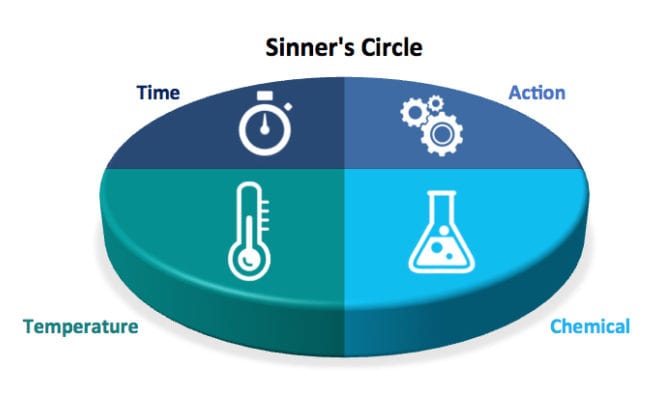
Ecolab’s Bogart describes the potential cause. “One of the potential downfalls of automation is the lack of employee engagement in the CIP of the equipment. Before automation, employees had to be intimately involved with the process. They controlled the valve pulses, temperature and time. With automation, they can now mash a button and walk away. That can lead to questions like: Did it wash, or did it wash efficiently, and did it wash correctly? How soon will someone read the wash chart and ensure all of the times, temperatures, flow rates and concentrations met the validated wash protocol? Depending upon regulations and third-party audit requirements, it can be up to seven days until these wash charts are verified. What else has happened in those seven days?” asks Bogart.
Ecolab has developed a way to answer those questions with 3D TRASA for CIP. This program captures readings from all the sensors noted above and monitors outputs to ensure the wash is completed in line with the validated wash recipe. If any of the critical factors that can impact product quality or food safety in the wash fall outside of the program’s critical parameters, a notification is sent to responsible personnel, immediately notifying them. This provides timely reporting—and processors no longer wait up to seven days to learn a piece of equipment did not function properly, potentially affecting product quality or food safety.
The Case for Pigging In CIP Systems
Many processes will benefit from pigging the line prior to CIP. The use of pigging must be considered early in the design of the CIP system so that the proper piping and valving can be used, or else significant cost can result from the re-design to accommodate the pig.
While almost all CIP cycles will include an initial water flush, some products, such as chocolate, cannot use water. Regardless of the product, pigging the line beforehand can significantly reduce the amount of water usage and can sometimes eliminate the need for water flush altogether. Additionally, less residue left in the lines can potentially reduce the length of chemical flushes resulting in chemical savings.
—Alan Maxwell, E Tech Group
Processing facilities that manufacture products like mayo, dressing, pastes and other viscous items can benefit from pigging. I was just working with a customer that was not pigging their lines and they had roughly 8% waste. When pigging was implemented, that number came down to 1%. When it comes to CIPing the lines—if you leave that 8% in the line circuit, it will take significantly more rinse water to remove it before starting the washing step. If completed properly, the pre-rinse needs to remove as much as 95% of the soil before starting the wash. This is so excess soil doesn’t tie up the chemistry, reducing the efficiency of the wash and requiring more chemistry to overcome the tied-up chemistry. Ultimately, this significantly reduces the amount of water in the CIP process and allows the system to get back into production more quickly.
—Neil Bogart, Ecolab Food & Beverage
LISTEN TO THIS PODCAST TO LEARN MORE ABOUT PIGGING
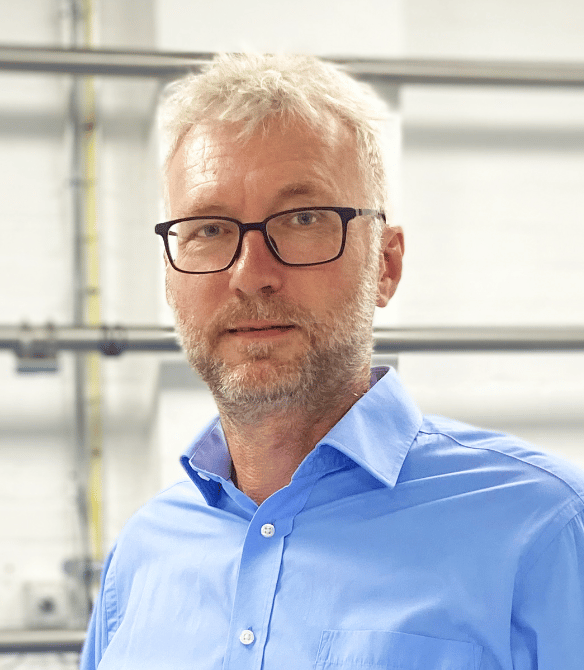
Peter Elgar, Director at HPS
FDA Recommendations on CIP for Raw and RTE Areas in the Plant
FDA recommends separate CIP systems for a facility that has both raw and cooked/RTE sections of the plant. Where this is not workable, FDA then recommends an alkaline cleaning solution at or above 71°C or 160°F. Certainly, new facilities can be designed with two separate CIP systems, but what about older facilities? What are the options?
Today, having separate raw and finished product CIPs is a best practice, says Tim Barthel, vice president of automation solutions at Cybertrol Engineering, a CSIA Certified member. “Buildings should be designed with physical separation to ensure crossing of raw and pasteurized product does not occur. We do have many situations we find with a single system, and due to potential allergens or other food safety concerns, it requires more refills/recharging of the chemical tanks.”
“Would separate CIP systems make sense in most facilities? Yes, and it would be my recommendation,” says Ecolab’s Bogart. “However, when you are looking at adding on to an existing system, it’s important to understand its utility capabilities. Does the boiler have enough capacity? This is usually the main concern.”
“That said, with separate systems, you won’t have to keep the system as hot,” adds Bogart. “The CIP skid tanks could be smaller, reducing water usage and chemical usage. The overall utility impact in most cases would be positive and support the separation. These are on top of the positive food safety impact within the process.”
“As most RTE and raw food systems are separate, it does make sense to have separate CIP systems, and where CIP is integrated into the original equipment, this will indeed be the case,” says HRS’s Hale. “It should be possible to design operationally separate CIP systems which cannot cross-contaminate each other, yet which still use the same source of cleaning solution, etc. to minimize system replication and wasting resources. Obviously if cleaning solution is to be reused, then this approach is not feasible, hence the FDA advice.”
“Yes, keeping the systems separate specifically for raw and RTE is a way to go,” says Novolyze’s Pearson. “When it comes to raw, reuse of water is a tricky situation. Water reuse can be done in different ways: Recycled water can be used to clean different areas of the plant, or more chemicals can be added to the recycled water to bring it up to the required concentration and use for cleaning. Recycling the water reduces the amount of both chemicals and water usage.”
“Separate CIP systems would make the most sense due to both the physical separation and for the ability to run the CIPs when you need them (and not),” says Sani-Matic’s Barrie. “When CIP is very far from the process being cleaned, not only does more supply and return piping need to be installed, but things like pressure drops become large and the CIP system (e.g., supply pump) may need to be oversized to run at the flows and pressures needed. With the separate CIP’s, slightly more water and chemical will be required since the circuits are not sharing a caustic/chemical tank for reuse. A smaller plant may combine these CIP functions due to capital investment, space, and/or because they aren’t running as many CIP cycles.”
An allergen is a protein, and these proteins are generally the hardest soil to remove from the surface. Some are water-soluble and some are not. Understanding the protein soils’ solubility in water is critical in the cleaning and sanitizing process. For example, dairy processing usually deals with non-water-soluble proteins attached to the equipment surface. To remove a non-water-soluble protein from the surface, an oxidizer like hypochlorite at 50-150 ppm in the wash solution can be used. The combination of the oxidizer and the sodium hydroxide increases the solubility of the protein at the higher pH, allowing for the protein’s removal from the surface. Graphic courtesy of Ecolab
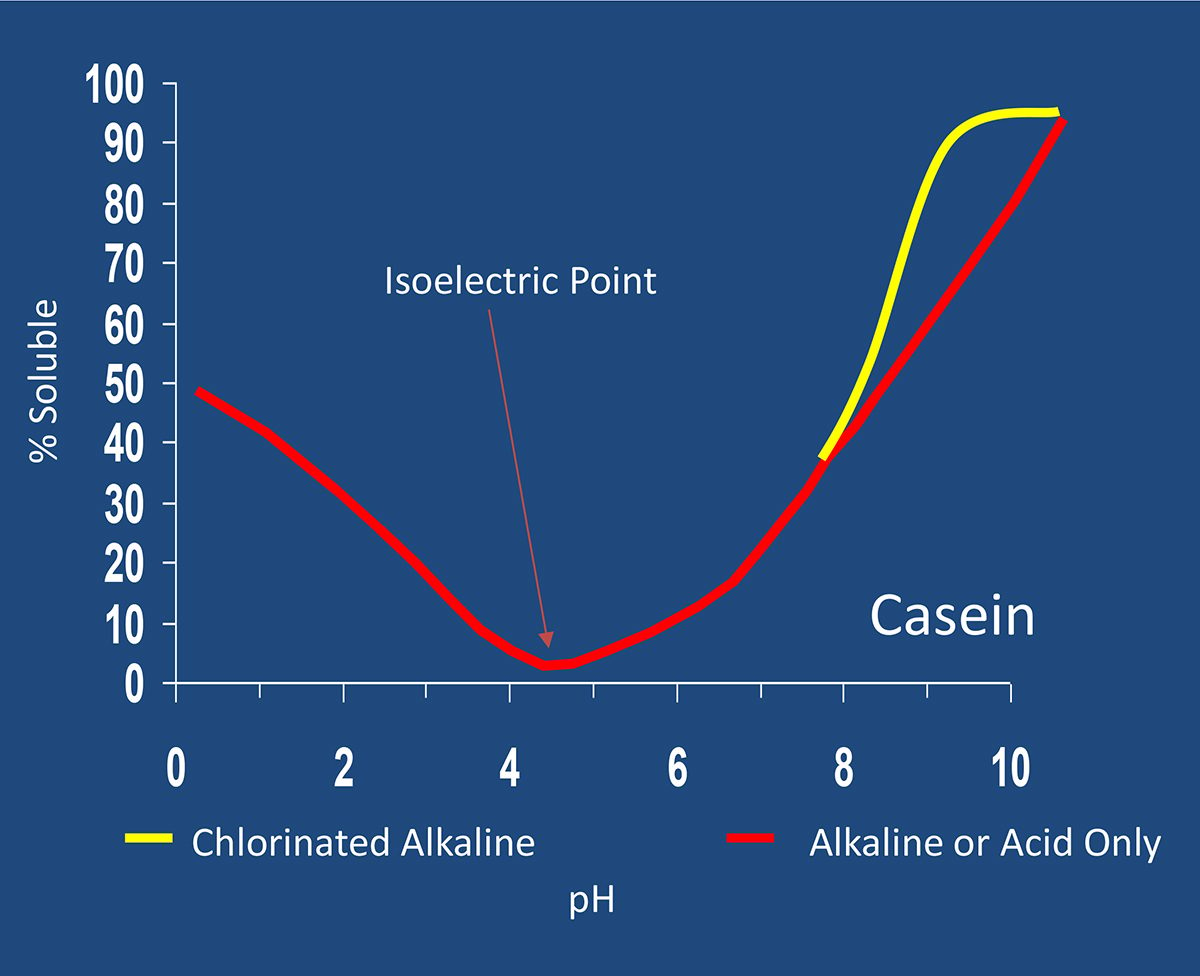
This question is prevalent in dairy plants, says Ericksen. “Yes, it makes sense to process raw and pasteurized equipment with separate CIP systems. As for the question about water reuse, I would not reuse any water used for flushing or rinsing on a single system that washes both raw and pasteurized milk. So, using two separate CIP systems would save water in this regard.”
Finally, a positive note on two separate systems from Chris Graham, Gray Solutions, principal consultant, process: “The extra cost of separate CIP systems will be easily offset with the increased operational efficiency and flexibility.” Water reuse would be localized for each system. Each CIP system would have its own set of tanks; cleaners, sanitizer and rinse he adds. FE
APRIL 2023



